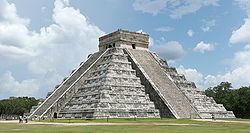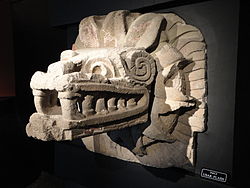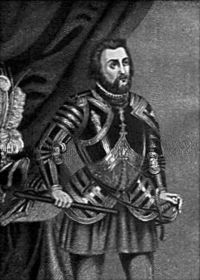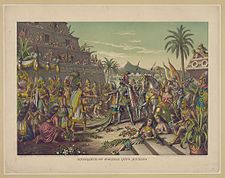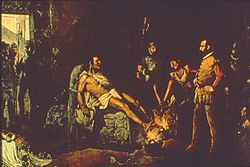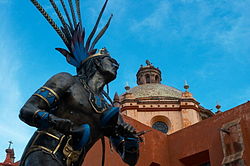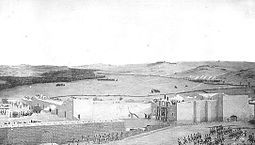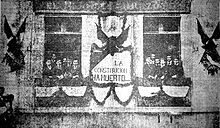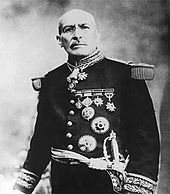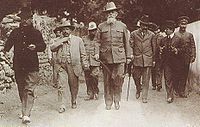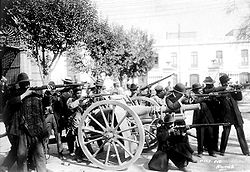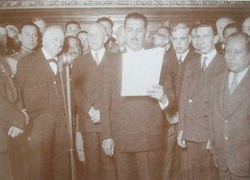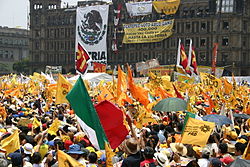- History of Mexico
-
History of Mexico 
This article is part of a seriesPre-Columbian Mexico Spanish conquest Colonial period War of Independence First Empire First Republic War with Texas Pastry War Mexican–American War Second Federal Republic The Reform Reform War French intervention Second Empire Restored Republic The Porfiriato Revolution La decena trágica Plan of Guadalupe Tampico Affair Occupation of Veracruz Cristero War The Maximato Petroleum nationalization Mexican miracle Students of 1968 La Década Perdida 1982 economic crisis Zapatista Insurgency 1994 economic crisis Downfall of the PRI
Mexico Portal
The history of Mexico, a country located in the southern portion of North America, covers a period of more than two millennia. First populated more than 13,000 years ago,[1] the country produced complex indigenous civilizations before being conquered by the Spanish in the 16th Century.
Since the Spanish Conquest, Mexico has fused its long-established native civilizations with European culture. Perhaps nothing better represents this hybrid background than Mexico's languages: the country is both the most populous Spanish-speaking country in the world and home to the largest number of Native American language speakers on the continent.
In 1519, the first Spaniards arrived and absorbed the native peoples into Spain's vast colonial empire. For three centuries, Mexico was a colony, during which time its indigenous population fell by more than half. After a protracted struggle Mexico declared its independence from Spain 1810. In 1846, the Mexican American War broke out, ending two years later with Mexico ceding almost half of its territory to the United States. Later in the 19th century, France invaded Mexico (1861) and set Maximilian I on the Mexican throne, which lasted until 1867.[2] The Mexican Revolution (1910–1929) resulted in the death of 10 percent of the nation's population, but brought to an end the system of large landholdings that had originated with the Spanish Conquest.
From the end of the Mexican Revolution, to the mid-1990s, Mexico was dominated by one political party, the authoritarian Partido Revolucionario Institucional (PRI). Beginning in the 1990s, the one-party political system established during the Mexican Revolution began to give way to a nascent democracy. True democracy was realized in the year 2000 with the election of Vicente Fox, the first president to not be from the PRI.
Prehistory and pre-Columbian civilizations
Main article: Pre-Columbian MexicoSources
The pre-history of Mexico is known through the work of archaeologists and epigraphers.
Accounts written by the Spanish at time of their conquest (the conquistadors) and by indigenous chroniclers of the post-conquest period constitute the principal source of information regarding a) Mexico at the time of the Spanish Conquest and b) the conquest itself.
While relatively few parchments (or codices) of the Mixtec and Aztec cultures of the Post-Classic period survive, progress has been made in the area of Mayan archaeology and epigraphy.[3]
Beginnings
The presence of people in Mesoamerica was once thought to date back 40,000 years, an estimate based on what were believed to be ancient footprints discovered in the Valley of Mexico; but after further investigation using radiocarbon dating, it appears this date may not be accurate.[4] It is currently unclear whether 21,000-year-old campfire remains found in the Valley of Mexico are the earliest human remains uncovered so far in Mexico.[5]
The first people to settle in Mexico encountered a climate far milder than the current one. In particular, the Valley of Mexico contained several large paleo-lakes surrounded by dense forest. Camels, bison, and deer roamed in large numbers.[citation needed] Such conditions encouraged the pursuit of a hunter-gatherer existence.
Corn, squash, and beans
The diet of ancient Mexico was varied, including corn (or maize), squashes such as pumpkin and butternut squash, common or pinto beans, tomatoes, peppers, cassava, pineapples, chocolate, and tobacco. The Three Sisters (corn, squash, and beans) constituted the principle diet.[citation needed]
Indigenous peoples in western Mexico began to selectively breed maize (Zea mays) plants from precursor grasses (e.g., teosinte) around 8000 BC,[6] and intensive corn farming began between 1800 and 1500 BC.[citation needed]
Religion
The Mesoamerican had the concept of god and religion, but were very different from Abrahamic concepts. The Mesoamericans had a belief where everything, every element of the cosmos, the earth, the sun, the moon, the stars, which mankind inhabits, everything that forms part of nature such as animals, plants, water and mountains all represented a manifestation of the supernatural. In most cases gods and goddesses are often depicted in stone reliefs, pottery decoration, wall paintings and in the various Maya, Aztec and Mixtec codices.
 Aztec calendar Sun Stone on display in Museo Nacional de Antropología
Aztec calendar Sun Stone on display in Museo Nacional de Antropología
The spiritual pantheon was vast and extremely complex. However, many of the deities depicted are common to the various civilizations and their worship survived over long periods of time. They frequently took on different characteristics and even names in different areas, but in effect they transcended cultures and time. Great masks with gaping jaws and monstrous features in stone or stucco were often located at the entrance to temples, symbolizing a cavern or cave on the flanks of the mountains that allowed access to the depths of Mother Earth and the shadowy roads that lead to the underworld. Cults connected with the jaguar and jade especially permeated religion throughout Mesoamerica. Jade, with its translucent green color was revered along with water as a symbol of life and fertility. The jaguar, agile, powerful and fast, was especially connected with warriors and as spirit guides of shamans. Despite differences of chronology or geography, the crucial aspects of this religious pantheon were shared amongst the people of ancient Mesoamerica. Thus, this quality of acceptance of new gods to the collection of existing gods may have been one of the shaping characteristics for the success during the Christianization of Mesoamerica. New gods did not at once replace the old; they initially joined the ever growing family of deities or were merged together with existing ones that seemed to share similar characteristics or responsibilities.[7]
Writing
Mesoamerica is the only place in the Americas where indigenous writing systems were invented and used before European colonization. While the types of writing systems in Mesoamerica range from minimalist "picture-writing" to complex logophonetic systems capable to recording speech and literature, they all share some core features that make them visually and functionally distinct from other writing systems of the world.[8]
The great civilizations
During the pre-Columbian period, many city-states, kingdoms, and empires competed with one another for power and prestige. Ancient Mexico can be said to have produced five major civilizations: the Olmec, Maya, Teotihuacan,Toltec, and Aztec. Unlike other indigenous Mexican societies, these civilizations (with the exception of the politically fragmented Maya) extended their political and cultural reach across Mexico and beyond. They consolidated power and exercised influence in matters of trade, art, politics, technology, and religion. Over a span of 3,000 years, other regional powers made economic and political alliances with them; many made war on them. But almost all found themselves within their spheres of influence.
The Olmec (1400-400 BC)
Main article: OlmecThe Olmec first appeared along the Atlantic coast (in what is now the state of Tabasco) in the period 1500-900 BC. The Olmecs were the first Mesoamerican culture to produce an identifiable artistic and cultural style, and may also have the society that invented writing in Mesoamerica. By the Middle Preclassic Period (900-300 BC), Olmec artistic styles had been adopted as far away as the Valley of Mexico and Costa Rica.
The Maya
Main article: Maya CivilizationMayan cultural characteristics, such as the rise of the ahau, or king, can be traced from 300 BC onwards. During the centuries preceding the classical period, Mayan kingdoms sprang up in an area stretching from the Pacific coasts of southern Mexico and Guatemala to the northern Yucatán Peninsula. The egalitarian Mayan society of pre-royal centuries gradually gave way to a society controlled by a wealthy elite that began building large ceremonial temples and complexes. The earliest known long-count date, 199 AD, heralds the classic period, during which the Mayan kingdoms supported a population numbering in the millions. Tikal, the largest of the kingdoms, alone had 500,000 inhabitants when the Spaniards came they brought disease guns and steel. With those tools they wiped out most of their civilization. (though the average population of a kingdom was much smaller—somewhere under 50,000 people). ...
The Teotihuacan
Main article: TeotihuacanTeotihuacan is an enormous archaeological site in the Basin of Mexico, containing some of the largest pyramidal structures built in the pre-Columbian Americas. Apart from the pyramidal structures, Teotihuacan is also known for its large residential complexes, the Avenue of the Dead, and numerous colorful, well-preserved murals. Additionally, Teotihuacan produced a thin orange pottery style that spread through Mesoamerica.[9]
The city is thought to have been established around 100 BCE and continued to be built until about 250 CE.[10] The city may have lasted until sometime between the 7th and 8th centuries CE. At its zenith, perhaps in the first half of the 1st millennium CE, Teotihuacan was the largest city in the pre-Columbian Americas. At this time it may have had more than 200,000 inhabitants, placing it among the largest cities of the world in this period. Teotihuacan was even home to multi-floor apartment compounds built to accommodate this large population.[10] The civilization and cultural complex associated with the site is also referred to as Teotihuacan or Teotihuacano. Although it is a subject of debate whether Teotihuacan was the center of a state empire, its influence throughout Mesoamerica is well documented; evidence of Teotihuacano presence can be seen at numerous sites in Veracruz and the Maya region. The Aztecs may have been influenced by this city. The ethnicity of the inhabitants of Teotihuacan is also a subject of debate. Possible candidates are the Nahua, Otomi or Totonac ethnic groups. Scholars have also suggested that Teotihuacan was a multiethnic state.
The Toltec
Main article: Toltec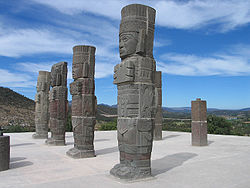 Columns in the form of Toltec warriors in Tula.
Columns in the form of Toltec warriors in Tula.
The Toltec culture is an archaeological Mesoamerican culture that dominated a state centered in Tula, Hidalgo in the early post-classic period of Mesoamerican chronology (ca 800-1000 CE). The later Aztec culture saw the Toltecs as their intellectual and cultural predecessors and described Toltec culture emanating from Tollan (Nahuatl for Tula) as the epitome of civilization, indeed in the Nahuatl language the word "Toltec" came to take on the meaning "artisan". The Aztec oral and pictographic tradition also described the history of the Toltec empire giving lists of rulers and their exploits. Among modern scholars it is a matter of debate whether the Aztec narratives of Toltec history should be given credence as descriptions of actual historical events. While all scholars acknowledge that there is a large mythological part of the narrative some maintain that by using a critical comparative method some level of historicity can be salvaged from the sources, whereas others maintain that continued analysis of the narratives as sources of actual history is futile and hinders access to actual knowledge of the culture of Tula, Hidalgo. Other controversy relating to the Toltecs include how best to understand reasons behind the perceived similarities in architecture and iconography between the archaeological site of Tula and the Maya site of Chichén Itzá - as of yet no consensus has emerged about the degree or direction of influence between the two sites.
The Aztec Empire (1325-1521 AD)
Main article: Aztec EmpireThe Nahua peoples began to enter central Mexico in the 6th Century AD. By the 12th Century, they had established their center at Azcapotzalco, the city of the Tepanecs.
The Mexica people arrived in the Valley of Mexico in 1248 AD. They had migrated from the deserts north of the Rio Grande[citation needed] over a period traditionally said to have been 100 years. They may have thought of themselves as the heirs to the prestigious civilizations that had preceded them.[citation needed] What the Aztec initially lacked in political power, however, they made up for with ambition and military skill. In 1325, they established the biggest city in the world at that time, Tenochtitlan.
Aztec religion was based on the belief that the universe required the constant offering of human blood to continue functioning; to meet this need, the Aztec sacrificed thousands of people. This belief is thought to have been common throughout Nahuatl people. To acquire captives in times of peace, the Aztec resorted to a form of ritual warfare called flower war. The Tlaxcalteca, among other Nahuatl nations, were forced into such wars.
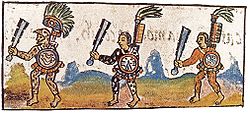 Aztec warriors as shown in the Florentine Codex.
Aztec warriors as shown in the Florentine Codex.
In 1428, the Aztec led a war of liberation against their rulers from the city of Azcapotzalco, which had subjugated most of the Valley of Mexico's peoples. The revolt was successful, and the Aztecs became the rulers of central Mexico as the leaders of the Triple Alliance. The alliance was composed of the city-states of Tenochtitlan, Texcoco, and Tlacopan.
At their peak, 350,000 Aztec presided over a wealthy tribute-empire comprising 10 million people, almost half of Mexico's estimated population of 24 million. Their empire stretched from ocean to ocean, and extended into Central America. The westward expansion of the empire was halted by a devastating military defeat at the hands of the Purepecha (who possessed weapons made of copper). The empire relied upon a system of taxation (of goods and services), which were collected through an elaborate bureaucracy of tax collectors, courts, civil servants, and local officials who were installed as loyalists to the Triple Alliance.
By 1519, the Aztec capital, Mexico-Tenochtitlan, the site of modern-day Mexico City, was one of the largest cities in the world, with a population of 30,000 (estimates range as high as 60,000).[citation needed]
The Spanish Conquest
Main article: Spanish Conquest of the Aztec EmpireMesoamerica on the Eve of the Conquest
The first mainland explorations were followed by a phase of inland expeditions and conquest. The Spanish crown extended the Reconquista effort, completed in Spain in 1492, to non-Catholic people in new territories. In 1502 on the coast of present day Colombia, near the Gulf of Urabá, Spanish explorers led by Vasco Núñez de Balboa explored and conquered the area near the Atrato River. The conquest was of the Chibchan speaking nations, mainly the Muisca and Tairona indigenous people that lived here. The Spanish founded San Sebastian de Uraba in 1509—abandoned within the year, and in 1510 the first permanent Spanish mainland settlement in America, Santa María la Antigua del Darién.[11] These were the first European settlements in America.[12][13]
There is a difference in the 'Spanish conquest of Mexico' between the Spanish conquest of the Aztec Empire and the Spanish conquest of Yucatán. The former is conquest of the campaign, led by Hernán Cortés from 1519–21 and his Tlaxcala and other 'indigenous peoples' allied against the Mexica/Aztec empire. The Spanish conquest of Yucatán is the much longer campaign, from 1551–1697, against the Maya peoples of the Maya civilization in the Yucatán Peninsula of present day Mexico and northern Central America. The day Hernán Cortés landed ashore at present day Veracruz, April 22, 1519, marks the beginning of 300 years of Spanish hegemony over the region.
The Aftermath
Tenochtitlan, the Aztecs, and the Tlaxcalteca
 Storming of the Teocalli by Cortez and His Troops
Storming of the Teocalli by Cortez and His Troops
Tenochtitlan had been almost totally destroyed by fire and cannon shots. Those Aztecs who survived were forbidden to live in the city and the surrounding isles, and they went to live in Tlatelolco.
Cortés imprisoned the royal families of the valley. To prevent another revolt, he personally tortured and killed Cuauhtémoc, the last Aztec Emperor; Coanacoch, the King of Texcoco, and Tetlepanquetzal, King of Tlacopan.
The Spanish had no intentions of turning over Tenochtitlan to the Tlaxcalteca. While Tlaxcalteca troops continued to help the Spaniards, and Tlaxcala received better treatment than other indigenous nations, the Spanish eventually disowned the treaty. Forty years after the conquest, the Tlaxcalteca had to pay the same tribute as any other indigenous community.
- Political. Apparently, Cortes favored maintaining the political structure of the Aztecs, subject to relatively minor changes.
- Religious. Cortes immediately banned human sacrifice throughout the conquered empire. Evangelization began in the mid-1520s and continued in the 1530s. Many of the evangelists learned the native languages and recorded aspects of native culture, providing a principal source for our knowledge about them. By 1560, more than 800 clergy were working to convert Indians in New Spain. By 1580, the number grew to 1,500 in 1580 and by 1650, to 3,000.
- Economics ... .
Analysis of the Defeat
Military Tactics. The Alliance's use of ambush during indigenous ceremonies allowed the Spanish to avoid fighting the best Aztec warriors in direct armed battle, such as during The Feast of Huitzilopochtli.
Smallpox and its Toll. Smallpox (Variola major and Variola minor) began to spread in Mesoamerica immediately after the arrival of Europeans. The indigenous peoples, who had no immunity to it, eventually died in the hundreds of thousands. A third of all the natives of the Valley of Mexico succumbed to it within six months of the arrival of the Spanish.
The Colonial Period (1521-1810)
Main article: Colonial MexicoThe capture of Tenochtitlan marked the beginning of a 300-year-long colonial period, during which Mexico was known as "New Spain".
Period of the Conquest (1521–1650)
 New Spain in 1803.
New Spain in 1803.
Contrary to a widespread misconception, Spain did not conquer all of the Aztec Empire when Cortes took Tenochtitlan. It required another two centuries to complete the conquest: rebellions broke out within the old Empire and wars continued with other native peoples.
After the fall of Tenochtitlan, it took decades of sporadic warfare to subdue the rest of Mesoamerica. Particularly fierce was the Chichimeca War (1576–1606) in the north.
Economics. The Council of Indies and the mendicant establishments, which arose in Mesoamerica as early as 1524, labored to generate capital for the crown of Spain and convert the Indian populations to Catholicism. During this period and the following Colonial periods the sponsorship of mendicant friars and a process of religious syncretism combined the Pre-Hispanic cultures with Spanish socio-religious tradition. The resulting hodgepodge of culture was a pluriethnic State that relied on the "repartimiento", a system of peasant "Republic of Indians" labor that carried out any necessary work. Thus, the existing feudal system of pre-Hispanic Mesoamerican culture was replaced by the encomienda feudal-style system of Spain, probably adapted to the pre-Hispanic tradition. This in turn was finally replaced by a debt-based inscription of labor that led to widespread revitalization movements and prompted the revolution that ended colonial New Spain.
Evolution of the Race. During the three centuries of colonial rule, less than 700,000 Spaniards, most of them men, settled in Mexico. The settlers intermarried with indigenous women, fathering the mixed race (mestizo) descendents who today constitute the majority of Mexico's population.
The Colonial Period (1650–1810)
During this period, Mexico was part of the much larger Viceroyalty of New Spain, which included Cuba, Puerto Rico, Central America as far south as Costa Rica, the southwestern United States, and the Philippines. Spain during the 16th Century focused its energies on areas with dense populations that had produced Pre-Columbian civilizations, since these areas could provide the settlers with a disciplined labor force and a population to catechize. Territories populated by nomadic peoples were harder to conquer, and though the Spanish did explore a good part of North America, seeking the fabled "El Dorado", they made no concerted effort to settle the northern desert regions in what is now the United States until the 17th Century.
Colonial law was in many ways destructive. No administrative office was open to any Mexican native, even those of pure Spanish blood. From an economic point of view, New Spain was administered principally for the benefit of Spain. For instance, the cultivation of grapes and olives, which grew particularly well in certain areas of the country, was banned out of fear that the harvest would compete with Spain's. Only two ports, morever, were open to foreign trade—Vera Cruz on the Atlantic and Acapulco on the Pacific. In fact, foreigners had to obtain a special permit from the Royal government to enter Mexico, and few Mexicans were permitted to travel abroad. Education was discouraged, and few books were available.
Mexican Independence and the 19th Century (1807-1910)
Main article: Mexican War of IndependenceAfter Independence (1821-1846)
Empire or Republic?
Further information: First Mexican RepublicPolitical Developments in the South and North
Santa Anna
- 19th Century Mexico (1807–1910)
The federalists asked Gen. Antonio López de Santa Anna to overthrow Bustamante; he did, declaring General Manuel Gómez Pedraza (who won the electoral vote in 1828) as president. Elections were held, and Santa Anna took office in 1832.
Constantly changing political beliefs, as president (he served as president 11 times),[14] in 1834, Santa Anna abrogated the federal constitution, causing insurgencies in the southeastern state of Yucatán and the northernmost portion of the northern state of Coahuila y Tejas. Both areas sought independence from the central government. Negotiations and the presence of Santa Anna's army brought Yucatán to recognize Mexican sovereignty, Santa Anna's army turned to the northern rebellion. The inhabitants of Tejas, calling themselves Texans and led mainly by relatively recently arrived English-speaking settlers, declared independence from Mexico at Washington-on-the-Brazos on 2 March 1836, giving birth to the Republic of Texas. At the Battle of San Jacinto on April 21, 1836, Texan militias defeated the Mexican army and captured General Santa Anna.
In 1845, the U.S. Congress ratified Texas' petition for statehood.
Central America
Central America, which at the time of Independence was still part of the Viceroyalty, broke away freely and in a pacific way from Mexico during 1822 and 1823 and formed the short-lived United Provinces of Central America.
The northern states grew increasingly isolated, economically and politically, due to prolonged Comanche raids and attacks. New Mexico in particular had been gravitating toward Comancheria. In the 1820s, when the United States began to exert influence over the region, New Mexico had already begun to question its loyalty to Mexico. By the time of the Mexican-American War, the Comanches had raided and pillaged large portions of northern Mexico, resulting in sustained impoverishment, political fragmentation, and general frustration at the inability—or unwillingness—of the Mexican government to discipline the Comanches.[15]
Texas
See also: Texas RevolutionSoon after achieving independence, the Mexican government, in an effort to populate its northern territories, awarded extensive land grants in Coahuila y Tejas to thousands of families from the United States, on condition that the settlers convert to Catholicism and become Mexican citizens. The Mexican government also forbade the importation of slaves. These conditions were largely ignored. A key factor in the decision to allow Americans in was the belief that they would a) protect northern Mexico from Comanche attacks and b) buffer the northern states against U.S. westward expansion. The policy failed on both counts: the Americans tended to settle far from the Comanche raiding zones and used the Mexican government's failure to suppress the raids as a pretext for declaring independence.[15]
The Texas Revolution or Texas War of Independence was a military conflict between Mexico and settlers in the Texas portion of the Mexican state Coahuila y Tejas.
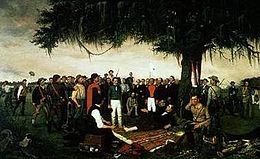 The painting "Surrender of Santa Anna" by William Huddle shows the Mexican president and general surrendering to a wounded Sam Houston
The painting "Surrender of Santa Anna" by William Huddle shows the Mexican president and general surrendering to a wounded Sam Houston
The war lasted from October 2, 1835 to April 21, 1836. However, a war at sea between Mexico and Texas would continue into the 1840s. Animosity between the Mexican government and the American settlers in Texas, as well as many Texas residents of Mexican ancestry, began with the Siete Leyes of 1835, when Mexican President and General Antonio López de Santa Anna abolished the federal Constitution of 1824 and proclaimed the more centralizing 1835 constitution in its place.
War began in Texas on October 2, 1835, with the Battle of Gonzales. Early Texian Army successes at La Bahia and San Antonio were soon met with crushing defeat at the same locations a few months later. The war ended at the Battle of San Jacinto where General Sam Houston led the Texian Army to victory over a portion of the Mexican Army under Santa Anna, who was captured shortly after the battle. The conclusion of the war resulted in the creation of the Republic of Texas in 1836.
War with the United States (1846-1853)
Main article: Mexican-American WarThe Mexican–American War was an armed conflict between the United States and Mexico from 1846 to 1848 in the wake of the 1845 U.S. annexation of Texas, which Mexico considered part of its territory despite the 1836 Texas Revolution. American forces invaded and conquered New Mexico, California, and parts of what is currently northern Mexico; meanwhile, the American Navy conducted a blockade, and took several garrisons on the Pacific coast of Mexico—largely what is now California, but also farther south. Another American army captured Mexico City, which forced Mexico to agree to the sale of its northern territories to the U.S. American territorial expansion to the Pacific coast was the goal of President James K. Polk, the leader of the Democratic Party.[16] However, the war was highly controversial in the U.S., with the Whig Party and anti-slavery elements strongly opposed. Heavy American casualties and high monetary cost were also criticized. The major consequence of the war was the forced Mexican Cession of the territories of Alta California and New Mexico to the U.S. in exchange for $18 million. In addition, the United States forgave debt owed by the Mexican government to U.S. citizens. Mexico accepted the Rio Grande as its national border, and the loss of Texas. Meanwhile gold was discovered in California, which immediately became an international magnet for the California Gold Rush. The political aftermath of the war raised the slavery issue in the U.S., leading to intense debates that pointed to civil war; the Compromise of 1850 provided a brief respite.
Santa Anna, Again
Santa Anna was Mexico's leader during the conflict with Texas. Santa Anna was in and out of power again during the Mexican-American War. After Texas joined the Union in 1846, the U.S. government sent troops to Texas to secure the territory, subsequently ignoring Mexico's demands for withdrawal. Mexico saw this as intervention in its internal affairs.
The Mexican-American War (1846–1848)
 The Brown Bess the Mexican army's basic weapon during the Mexica-American War
The Brown Bess the Mexican army's basic weapon during the Mexica-American War
In response to a Mexican attack on Fort Texas (subsequently renamed Fort Brown), the U.S. Congress declared war on May 13, 1846; Mexico followed suit on 23 May. Thus began the Mexican–American War, which took place in two phases: the western (aimed at securing California) and Central Mexico (aimed at capturing Mexico City) campaigns. The California campaign was brief and involved mostly skirmishes: the main Mexican resistance came from the Californios, and no side fielded more than 700 men in any fighting. The United States completed its occupation of California by January 1847.
The Mexico City Campaign
 The amphibious assault on Veracruz
The amphibious assault on Veracruz
In March 1847, U.S. President James K. Polk sent an army of 12,000 volunteer and regular soldiers under General Winfield Scott to the port of Veracruz. The 70 ships of the invading forces arrived at the city on 7 March and began a naval bombombardment. After landing his men, horses, and supplies, Scott began the Siege of Veracruz. The city (at that time still walled) was defended by Mexican General Juan Morales with 3,400 men. Veracruz replied as best it could with artillery to the bombardment from land and sea, but the city walls were reduced. After 12 days, the Mexicans surrendered. By far the greatest number of casualties on the U.S. side was due to yellow fever, which significantly reduced the number of active American troops.[citation needed]
Scott marched west with 8,500 men, while Santa Anna entrenched with artillery and 12,000 troops on the main road halfway to Mexico City (the Battle of Cerro Gordo Cerro ). Santa Anna's guns were trained on the road, but Scott sent 2,600 mounted dragoons ahead, and Mexican artillery prematurely fired on them, revealing their positions. Armed with this vital information, Scott ordered his troops to trek through the rough terrain to the north, setting up his artillery on the high ground and flanking Santa Anna. Although aware of the positions of U.S. troops, the Mexican army was unprepared for the ensuing onslaught and was routed.
Scott pushed on to Puebla, Mexico's second largest city, which capitulated without resistance on 1 May—the citizens were hostile to Santa Anna. After the Battle of Chapultepec (13 September 1847), Mexico City was occupied; Scott became its military governor. Many other parts of Mexico were also occupied.
Some Mexican units fought with distinction. One of the justly commemorated units was a group of six young Military College cadets (now considered Mexican national heroes). These cadets fought to the death defending their college during the Battle of Chapultepec. Another group revered by Mexicans was the Batallón de San Patricio, a unit composed of hundreds of mostly Irish-born American deserters who fought under Mexican command until the overwhelming defeat at the Battle of Churubusco (20 August 1847). Most of the San Patricios were killed; many of those taken prisoner were court-martialled as traitors and executed at Chapultepec.
The Terms of Surrender
The war ended with the Treaty of Guadalupe Hidalgo, which stipulated that a) Mexico must sell its northern territories to the United States for US $15 million; b) the United States would protect the property rights of Mexicans living in the ceded territories; and c) the United States would assume $3.25 million in debt owed by Mexico to U.S. citizens.
Analysis of the Defeat
 American occupation of Mexico City
American occupation of Mexico City
The Mexican-American War was independent Mexico's first encounter with a large, well-organized and -equipped army. After having won two wars against Spain and, France, Mexico was overwhelmed by the number of European countries that wanted to colonize the American continent
The primary reason for Mexico's defeat was its problematic internal situation, which led to a lack of unity and organization for a successful defense.
The Gadsen Purchase
The United States had not realized when it was negotiating the Treaty of Hidalgo that a much easier railroad route to California lay slightly south of the Gila River, which the treaty designated part of the border between the two countries. In 1853, President Santa Anna sold off the Gadsden Strip to the US for $5 million. This loss of still more territory provoked considerable outrage among the Mexican populace, but Santa Anna claimed that he needed money to rebuild the army from the war. In the end, he squandered most of it. The Southern Pacific Railroad, the second transcontinental railroad to California, was built through this purchased land in 1881.
The Struggle for Liberal Reform (1855-1872)
Main article: La ReformaLa Reforma was a period halfway through the 19th century in the history of Mexico that was characterized by liberal reforms and the transformation of Mexico into a nation state. A new generation of political figures came to power who were shocked at the ease by which Mexico had lost to the United States in 1848. Notable liberal politicians in the reform period include Benito Juárez, Juan Álvarez, Ignacio Comonfort, Miguel Lerdo de Tejada, Sebastián Lerdo de Tejada, Melchor Ocampo, José María Iglesias and Santos Degollado. The Reforma is usually considered to have begun with the overthrowing and removal of Antonio López de Santa Anna in the Revolution of Ayutla in 1855. There is less consensus about the ending point of the Reforma. Common dates are 1861, after the liberal victory in the Reform War, 1867, after the republican victory of the French intervention in Mexico and 1876 after the Rebellion of Tuxtepec in which Porfirio Díaz overthrew president Sebastián Lerdo de Tejada.
Santa Anna and Benito Juarez
In 1855, the Liberal Party overthrew Santa Anna during the Revolution of Ayutla. The moderate Liberal Ignacio Comonfort became president. The Moderados tried to find a middle ground between the nation's liberals and conservatives.
The 1857 Constitution
During Comonfort's presidency, the Constitution of 1857 was drafted creating the Second Federal Republic of Mexico. The new constitution retained most of the Roman Catholic Church's Colonial-era privileges and revenues. Up to this point, the Church controlled most education in Mexico in addition to large tracts of land and also sent considerable sums of money back to Rome. The 1857 constitution granted religious freedom, stating only that the Catholic Church was the favored faith. Such reforms were unacceptable to the leadership of the clergy and the conservatives. Comonfort and members of his administration were excommunicated, and a revolt broke out.
The War of Reform
The revolt led to the War of Reform (December 1857 to January 1861), which grew increasingly bloody as it progressed and polarized the nation's politics. Many Moderates, convinced that the Catholic Church's political power had to be curbed, came over to the side of the Liberals. For some time, the Liberals and Conservatives simultaneously administered separate governments, the Conservatives from Mexico City and the Liberals from Veracruz. The war ended with a Liberal victory, and liberal President Benito Juárez moved his administration to Mexico City.
French Intervention and the Second Mexican Empire (1861-1867)
Main article: French intervention in Mexico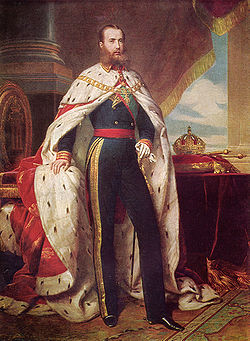 Portrait of Maximilian I of Mexico, by Franz Xaver Winterhalter
Portrait of Maximilian I of Mexico, by Franz Xaver Winterhalter
In the 1860s, the country was again invaded, this time by France, which installed the Habsburg Archduke Ferdinand Maximilian of Austria as Emperor Maximilian I of Mexico, with support from the Roman Catholic clergy, conservative elements of the upper class, and some indigenous communities. Although the French suffered an initial defeat (the Battle of Puebla--now commemorated as the Cinco de Mayo holiday), they eventually defeated the Mexican army and set Maximilian on the throne.
The Mexican-French monarchy set up administration in Mexico City, governing from the National Palace. Maximilian's consort was Empress Carlota of Mexico. The Imperial couple chose as their home Chapultepec Castle.
The Imperial couple noticed how the people of Mexico (and especially the Indians) were treated, and wanted to ensure their human rights. They were interested in a Mexico for the Mexicans, and did not share the views of Napoleon III, who was interested in exploiting the rich mines in the northwest of the country.
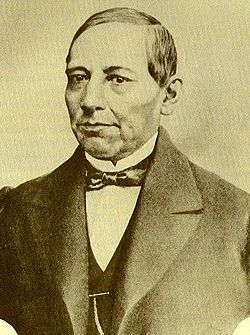 Benito Juárez, President of Mexico (1861–1863 and 1867–1872)
Benito Juárez, President of Mexico (1861–1863 and 1867–1872)
Maximilian was a liberal: he favored the establishment of a limited monarchy, one that would share its powers with a democratically elected congress. This was too liberal to please Mexico's Conservatives, while the liberals refused to accept a monarch, leaving Maximilian with few enthusiastic allies within Mexico. President Benito Juárez kept the federal government functioning during the French intervention that put Maximilian in power.
After taking power, Maximilian also received a letter from Rome requesting full restoration of church privileges in Mexico, but he declared that the Mexican people and not outsiders would decide this.
Meanwhile, the Mexican expedition was unpopular with the French public as it was both expensive and seemed to produce little if any value for France. Finally in the spring of 1865, with the Civil War over, the United States demanded the withdrawal of French troops from Mexico, which the latter quietly complied with.
In mid-1867, following repeated losses in battle to the Republican Army and ever decreasing support from Napoleon III, Maximilian was captured and executed by Juárez's soldiers. From then on, Juárez remained in office until his death in 1872.
Benito Juarez and the Restoration of the Republic (1867-1872)
In 1867, the republic was restored and Juárez reelected; he continued to implement his reforms. In 1871, he was elected a second time, much to the dismay of his opponents within the Liberal party, who considered reelection to be somewhat undemocratic. Juárez died one year later and was succeeded by Sebastián Lerdo de Tejada. Part of Juarez's reforms included fully secularizing the country. The Catholic Church was barred from owning property aside from houses of worship and monasteries, and education and marriage were put in the hands of the state.
The Porfiriato (1876-1911)
Order, Progress, and Dictatorship
Porfirio Díaz, President of Mexico, (1876-1911)
In 1876, Lerdo was reelected, defeating Porfirio Díaz. Díaz rebelled against the government with the proclamation of the Plan de Tuxtepec, in which he opposed reelection, in 1876. Díaz managed to overthrow Lerdo, who fled the country, and was named president.
Díaz became the new president. Thus began a period of more than 30 years (1876–1911) during which Díaz was Mexico's strong man. This period of relative prosperity and peace is known as the Porfiriato. During this period, the country's infrastructure improved greatly, thanks to increased foreign investment and a strong, stable central government. Increased tax revenues and better administration brought many improvements, including the development of a national health service, better communications network, investment in infrastructure, and development of a national educational system. Under Díaz, the population increased to 16 million and life expectancy reached 60 years. Illiteracy diminished greatly, approaching levels of France and Italy. However, the period was also characterized by social inequality and discontent among the working classes.
Foreign capital helped build Mexico into an industrial and mining power, but the wealth did not trickle down to the masses who remained in abject poverty. Much of the nation's infrastructure was owned by foreigners, and Britain once contemplated running its navy off of Mexican oil. By 1900, it was obvious to all concerned that Mexico was an economic satellite of the United States and little more than a source of raw materials for the great powers.
Slavery had been abolished in 1824, 1835, and 1857, but in the 1880s it was estimated that thousands (especially in the south of the country) were still held in bondage. Some farmers were paid laborers, but most were little more than serfs on great estates. Disease and starvation were commonplace on the plantations, and working conditions little better in the cities. All attempts at unionization were quickly suppressed, and injured workers were frequently thrown out into the street to die. Those too old and/or incapacitated to work were reduced to beggary. Periodic protests were suppressed with force.
The Mexican Revolution (1910-1929)
See also: Mexican RevolutionFirst Phase: The Constitution of 1917 (1910-1921)
The Election of 1910
In 1910, the 80-year-old Díaz decided to hold an election for another term; he thought he had long since eliminated any serious opposition. However, Francisco I. Madero, an academic from a rich family, decided to run against him and quickly gathered popular support, despite his arrest and imprisonment by Díaz.
 Leaders of the 1910 revolt pose for a photo after the First Battle of Juárez. Present are José María Pino Suárez, Venustiano Carranza, Francisco I. Madero (and his father), Pascual Orozco, Pancho Villa, Gustavo Madero, Raul Madero, Abraham González, and Giuseppe Garibaldi Jr.
Leaders of the 1910 revolt pose for a photo after the First Battle of Juárez. Present are José María Pino Suárez, Venustiano Carranza, Francisco I. Madero (and his father), Pascual Orozco, Pancho Villa, Gustavo Madero, Raul Madero, Abraham González, and Giuseppe Garibaldi Jr.
When the official election results were announced, it was declared that Díaz had won reelection almost unanimously, with Madero receiving only a few hundred votes in the entire country. This fraud by the Porfiriato was too blatant for the public to swallow, and riots broke out. On November 20, 1910, Madero prepared a document known as the Plan de San Luis Potosí, in which he called the Mexican people to take up weapons and fight against the Díaz government. Madero managed to flee prison, escaping to San Antonio, Texas, where he began preparations for the overthrow of Díaz—an action today regarded as the start of the Mexican Revolution.
Diaz attempted to use the army to suppress the revolts, but most of the ranking generals were old men close to his own age and they did not act swiftly or with sufficient energy to stem the chaos.
Revolutionary force—led by, among others, Emiliano Zapata in the South, Pancho Villa and Pascual Orozco in the North, and Venustiano Carranza--defeated the Federal Army, and Díaz resigned in 1911 for the "sake of the peace of the nation." He went into exile in France, where he died in 1915 at the age of 85.
Violent Disagreements (1911–1920)
 Pancho Villa and Emiliano Zapata. Villa is sitting in the presidential throne in the Palacio Nacional at the left.
Pancho Villa and Emiliano Zapata. Villa is sitting in the presidential throne in the Palacio Nacional at the left.
The revolutionary leaders had many different objectives; revolutionary figures varied from liberals such as Madero to radicals such as Emiliano Zapata and Pancho Villa. As a consequence, it proved impossible to reach agreement on how to organize the government that emerged from the triumphant first phase of the revolution. This standoff over political principles lead quickly to a struggle for control of the government, a violent conflict that lasted more than 20 years. Although this period is usually referred to as part of the Mexican Revolution, it might also be termed a civil war. Presidents Francisco I. Madero (1913), Venustiano Carranza (1920), and former revolutionary leaders Emiliano Zapata (1919) and Pancho Villa (1923) all were assassinated during this period.
Following the resignation of Díaz and a brief reactionary intercourse, Madero was elected president in 1911, only to be ousted and killed in 1913 by Victoriano Huerta, one of Diaz' generals. This coup had the support of the U.S. ambassador to Mexico, Henry Lane Wilson, but not that of U.S. President-elect Woodrow Wilson. Huerta's brutality soon lost him domestic support, and the Wilson Administration actively opposed his regime, for example by the naval bombardment of Veracruz.
In 1915, Huerta was overthrown by Venustiano Carranza, a former revolutionary general. Carranza promulgated a new constitution on February 5, 1917. The Mexican Constitution of 1917 still governs Mexico.
On 19 January 1917, telegram (Zimmermann Telegram) was forwarded from Germany to Mexico proposing military action should the United States declare war against Germany. The offer included material aid to Mexico to assist in the reclamation of territory lost during the Mexican-American War, specifically the American states of Texas, New Mexico and Arizona. Carranza consulted with his generals about this, and was told there was no realistic possibility of retaking Mexico's former territories. The nation could not rely on Europe (then engulfed in World War I) for military aid, and the United States was the only major armaments manufacturer in the Western Hemisphere. There was also the difficulties of subduing and assimilating the Anglo population of the Southwest.
Carranza formally declined Zimmermann's proposals on 14 April, by which time the United States had declared war on Germany.
Carranza was assassinated in 1919 during an internal feud among his former supporters over who would replace him as president.
Obregon and Liberalization (1921–1926)
In 1920, Álvaro Obregón, one of Carranza's allies who had plotted against him, became president. His government managed to accommodate all elements of Mexican society except the most reactionary clergy and landlords; as a result, he was able to successfully catalyze social liberalization, particularly in curbing the role of the Catholic Church, improving education, and taking steps toward instituting women's civil rights.
While the Mexican Revolution may have subsided after 1920, armed struggle continued. The most widespread conflict was the fight between those favoring separation of Church and State and those favoring supremacy of the Roman Catholic Church. This fight developed into an armed uprising by supporters of the Church--"la Guerra Cristera."
It is estimated that between 1910 and 1921, 900,000 people died.
Second Phase: The Cristero War (1926-1929)
Main article: Cristero WarThe Cristero War of 1926 to 1929 was an uprising and counter-revolution against the Mexican government of the time, set off by religious persecution of Christians, especially Roman Catholics,[17] and specifically the strict enforcement of the anti-clerical provisions of the Mexican Constitution of 1917 and the expansion of further anti-clerical laws. After a period of peaceful resistance, a number of skirmishes took place in 1926. The formal rebellions began on January 2, 1927,[18] with the rebels calling themselves Cristeros because they felt they were fighting for Christ himself. Just as the Cristeros began to hold their own against the federal forces, the rebellion was ended by diplomatic means, brokered by the US Ambassador Dwight Whitney Morrow.
Secular/Religious
 Cristeros (Catholic rebels) hung in Jalisco
Cristeros (Catholic rebels) hung in Jalisco
In 1926, an armed conflict in the form of a popular uprising broke out against the anti-Catholic\anti-clerical Mexican government, set off specifically by the anti-clerical provisions of the Mexican Constitution of 1917. Discontent over the provisions had been simmering for years. The conflict is known as the Cristero War. A number of articles of the 1917 Constitution were at issue: a) Article 5 (outlawing monastic religious orders); b) Article 24 (forbidding public worship outside of church buildings); and c) Article 27 (restricting religious organizations' rights to own property). Finally, Article 130 took away basic civil rights of the clergy: priests and religious leaders were prevented from wearing their habits, were denied the right to vote, and were not permitted to comment on public affairs in the press.
The Cristero War was eventually resolved diplomatically, largely with the help of the U.S. Ambassador, Dwight Whitney Morrow. The conflict claimed 90,000 lives: 56,882 on the federal side, 30,000 Cristeros, and civilians and Cristeros killed in anticlerical raids after the war's end. As promised in the diplomatic resolution, the laws considered offensive by the Cristeros remained on the books, but the federal government made no organized attempt to enforce them. Nonetheless, persecution of Catholic priests continued in several localities, fueled by local officials' interpretation of the law.[19]
The Institutional Revolutionary Party (PRI) (1929-2000)
One-Party Rule
See also: Confederation of Mexican WorkersIn 1929, the National Mexican Party (PNM) was formed by the president, General Plutarco Elías Calles. The PNM convinced most of the remaining revolutionary generals to hand over their personal armies to the Mexican Army; the party's foundation is thus considered by some the end of the Revolution.
Later renamed the Partido Revolucionario Institucional (PRI), the new party ruled Mexico for the rest of the 20th century.
The PRI set up a new type of system, led by a caudillo.
The party is typically referred to as the three-legged stool, in reference to Mexican workers, peasants, and bureaucrats.
After its establishment as the ruling party, the PRI monopolized all the political branches: it did not lose a senate seat until 1988 or a gubernatorial race until 1989.[20] It wasn't until July 2, 2000, that Vicente Fox of the opposition "Alliance for Change" coalition, headed by the National Action Party (PAN), was elected president. His victory ended the PRI's 71-year hold on the presidency.
President Lázaro Cárdenas
President Lázaro Cárdenas came to power in 1934 and transformed Mexico. On April 1, 1936, he exiled Calles, the last general with dictatorial ambitions, thereby removing the army from power.
Cárdenas managed to unite the different forces in the PRI and set the rules that allowed his party to rule unchallenged for decades to come without internal fights. He nationalized the oil industry (on 18 March 1938), the electricity industry, created the National Polytechnic Institute, granted asylum to Spanish expatriates fleeing the Spanish Civil War, and started land reform and the distribution of free textbooks to children.
On the eve of World War II, the Cárdenas administration (1934–1940) was just stabilizing, and consolidating control over, a Mexican nation that, for decades, had been in revolutionary flux,[21] and Mexicans were beginning to interpret the European battle between the communists and fascists, especially the Spanish Civil War, through their unique revolutionary lens. Whether Mexico would side with the United States was unclear during Lázaro Cárdenas' rule, as he remained neutral. “Capitalists, businessmen, Catholics, and middle-class Mexicans who opposed many of the reforms implemented by the revolutionary government sided with the Spanish Falange”[22] i.e., the fascist movement, and Nazi propagandist Arthur Dietrich and his team of agents in Mexico successfully manipulated editorials and coverage of Europe by paying hefty subsidies to Mexican newspapers, including the widely-read dailies Excélsior and El Universal.[23] The situation became even more worrisome for the Allies when major oil companies boycotted Mexican oil following Lázaro Cárdenas' nationalization of the oil industry and expropriation of all corporate oil properties in 1938,[24] which severed Mexico's access to its traditional markets and led Mexico to sell its oil to Germany and Italy.[25]
President Manuel Ávila Camacho
Manuel Ávila Camacho, Cárdenas's successor, presided over a "bridge" between the revolutionary era and the era of machine politics under PRI that lasted until 2000. Ávila, moving away from nationalistic autarchy, proposed to create a favorable climate for international investment, favored nearly two generations earlier by Madero. Ávila's regime froze wages, repressed strikes, and persecuted dissidents with a law prohibiting the "crime of social dissolution." During this period, the PRI regime thus betrayed the legacy of land reform. Miguel Alemán Valdés, Ávila's successor, even had Article 27 amended to protect elite landowners. During his government, Manuel Ávila Camacho had to deal with the start of World War II, and Mexican involvement in it on the side of the Allies.
Mexico in World War II
 A pilot standing in front of his P-47D with a maintenance crew after a combat mission
A pilot standing in front of his P-47D with a maintenance crew after a combat mission
In Mexico and throughout Latin America, Franklin Roosevelt's “Good Neighbor Policy” was necessary at such a delicate time, and in the case of the Mexicans, ultimately led to the Douglas-Weichers Agreement in June 1941 that secured Mexican oil only for the United States,[26] and the Global Settlement in November 1941 that ended oil company demands on generous terms for the Mexicans, a rare example of the U.S. putting national security concerns over the interests of American oil companies.[27]
Following losses of oil ships in the Gulf (the Potrero del Llano and Faja de Oro) to German submarines (U-564 and U-106 respectively) the Mexican government declared war on the Axis powers on 22 May 1942. Perhaps the most famous fighting unit in the Mexican military was the Escuadrón 201, also known as the Aztec Eagles. This group consisted of more than 300 volunteers, who had trained in the United States to fight against Japan (of which had desired to occupy based on its wartime plans). The Escuadrón 201 was the first Mexican military unit trained for overseas combat, and fought during the liberation of the Philippines, working with the U.S. Fifth Air Force in the last year of the war.[28]
Although most American countries eventually entered the war on the Allies' side, Mexico and Brazil were the only Latin American nations that sent troops to fight overseas during World War II.
In the civil arena, the Bracero Program gave the opportunity for many thousands of Mexicans to work in the USA in support of the war effort. This also granted them an opportunity to gain US citizenship by enlisting in the military.
The Mexican Economic Miracle (1930-1970)
During the next four decades, Mexico experienced impressive economic growth (albeit from a low baseline), an achievement historians call "El Milagro Mexicano," the Mexican Economic Miracle. Annual economic growth during this period averaged 3–4 percent, with a modest 3-percent annual rate of inflation. The miracle, moreover, was solidly rooted in government policy: 1) an emphasis on primary education that tripled the enrollment rate between 1929 and 1949; 2) high tariffs on imported domestic goods; and 3) public investment in agriculture, energy, and transportation infrastructure. Starting in the 1940s, immigration into the cities swelled the country's urban population.
The economic growth occurred in spite of falling foreign investment during the Great Depression. The assumption of mineral rights and subsequent nationalisation of the oil industry into Pemex during the presidency of Lázaro Cárdenas del Río was a popular move.
The Economic Crisis (1970-1994)
Although PRI administrations achieved economic growth and relative prosperity for almost three decades after World War II, the party's management of the economy led to several crises. Political unrest grew in the late 1960s, culminating in the Tlatelolco massacre in 1968. Economic crises swept the country in 1976 and 1982, leading to the nationalization of Mexico's banks, which were blamed for the economic problems (La Década Perdida). On both occasions, the Mexican peso was devalued, and, until 2000, it was normal to expect a big devaluation and recession at the end of each presidential term. The "December Mistake" crisis threw Mexico into economic turmoil—the worst recession in over half a century.
The end of the PRI's rule
Accused many times of blatant fraud, the PRI held almost all public offices until the end of the 20th Century. Not until the 1980s did the PRI lose its first state governorship, an event that marked the beginning of the party's loss of hegemony.
Contemporary Mexico
1985 Earthquake
 Apartment Complex Pino Suárez, 1985 Mexico City earthquake
Apartment Complex Pino Suárez, 1985 Mexico City earthquake
On 19 September 1985, an earthquake (8.1 on the Richter scale) struck Michoacán, inflicting severe damage on Mexico City. Estimates of the number of dead range from 6,500 to 30,000. (See 1985 Mexico City earthquake.) Public anger at the PRI's mishandling of relief efforts combined with the ongoing economic crisis led to a substantial weakening of the PRI. As a result, for the first time since the 1930s, the PRI began to face serious electoral challenges.
President Ernesto Zedillo (in office, 1994–2000)
In 1995, President Ernesto Zedillo faced the "December Mistake" economic crisis, triggered by a sudden devaluation of the peso. There were public demonstrations in Mexico City and a constant military presence after the 1994 rising of the Zapatista Army of National Liberation in Chiapas.
The United States intervened rapidly to stem the economic crisis, first by buying pesos in the open market, and then by granting assistance in the form of $50 billion in loan guarantees. The peso stabilized at 6 pesos per dollar. By 1996, the economy was growing, and in 1997, Mexico repaid, ahead of schedule, all U.S. Treasury loans.
Zedillo oversaw political and electoral reforms that reduced the PRI's hold on power. After the 1988 election, which was strongly disputed and arguably lost by the government, the IFE (Instituto Federal Electoral – Federal Electoral Institute) was created in the early 1990s. Run by ordinary citizens, the IFE oversees elections with the aim of ensuring that they are conducted legally and impartially.
NAFTA and Economic Resurgence (1994-present)
 Logo of the North American Free Trade Agreement (NAFTA)
Logo of the North American Free Trade Agreement (NAFTA)
On 1 January 1994, Mexico became a full member of the North American Free Trade Agreement (NAFTA), joining the United States of America and Canada. In 2005, North American economic integration was further strengthened by the signing of the Security and Prosperity Partnership of North America.
Mexico has a free market economy that recently entered the trillion-dollar class.[29] It contains a mixture of modern and outmoded industry and agriculture, increasingly dominated by the private sector. Recent administrations have expanded competition in sea ports, railroads, telecommunications, electricity generation, natural gas distribution, and airports. Per capita income is one-quarter that of the United States; income distribution remains highly unequal. Trade with the United States and Canada has tripled since the implementation of NAFTA. Mexico has free-trade agreements with more than 40 countries, governing 90% of its foreign commerce.
President Vicente Fox Quesada (in office, 2000–2006)
Emphasizing the need to upgrade infrastructure, modernize the tax system and labor laws, and allow private investment in the energy sector, Vicente Fox Quesada, the candidate of the National Action Party (PAN), was elected the 69th president of Mexico on 2 July 2000, ending PRI's 71-year-long control of the office. Though Fox's victory was due in part to popular discontent with decades of unchallenged PRI hegemony, also, Fox's opponent, president Zedillo, conceded defeat on the night of the election—a first in Mexican history. A further sign of the quickening of Mexican democracy was the fact that PAN failed to win a majority in both chambers of Congress—a situation that prevented Fox from implementing his reform pledges. Nonetheless, the transfer of power in 2000 was quick and peaceful.
President Felipe Calderón Hinojosa (incumbent president)
President Felipe Calderón Hinojosa (of PAN) took office after one of the most hotly contested in recent Mexican history; Calderón won by such a small margin (.56% or 233 thousand 831 votes.)[30] that the runner-up, Andrés Manuel López Obrador of the leftist Party of the Democratic Revolution (PRD), denounced mayor irregularities and claimed the election was stolen, demanding a new full count of votes. Intellectuals backed López Obrador and requested the new full count of votes using the slogan "voto por voto"[31] (Count each vote). Nevertheless, on 5 September 2006, the Federal Electoral Tribunal (TEPJF) determined that even the irregularities denounced by the PRD lead coalition had actually occurred, itself they did not were determinant to call a new full count of the votes as requested by Lopez Obrador,[32] therefore Calderón had met the constitutional requirements for election and declared him president-elect.
A New Struggle: The War Against Drugs
 Mexican army in Apatzingán in 2007.
Mexican army in Apatzingán in 2007. See also: Mexican Drug War
See also: Mexican Drug WarMexico is a major transit and drug-producing nation: an estimated 90% of the cocaine smuggled into the United States every year moves through Mexico and fueled by the increasing demand for drugs in the United States, the country has become a major supplier of heroin, producer and distributor of ecstasy, and the largest foreign supplier of marijuana and methamphetamine to the U.S.'s market. Major drug syndicates control the majority of drug trafficking in the country, and Mexico is a significant money-laundering center.[29]
After the Federal Assault Weapons Ban expired on September 13, 2004 in the United States, the Mexican President Calderon Hinojosa decided to use brute force to combat some drug lords, in 2007 started a major escalation on the Mexican Drug War. Mexican drug lords found it easy to buy Assault weapons in the United States.[33] The result is that drug cartels have now both more gun power, and more manpower due to the high unemployment in Mexico.[34] Cultivation has increased too: Cultivation of opium poppy in 2007 rose to 17,050 acres (69.0 km2), yielding a potential production of 19.84 tons of pure heroin or 55.12 tons of "black tar" heroin. Black tar is the dominant form of Mexican heroin consumed in the western United States. Marijuana cultivation increased to 21,992 acres (89.00 km2) in 2007, yielding a potential production of 17,416.52 tons.[citation needed]
The Mexican government conducts the largest independent illicit-crop eradication program in the world, but Mexico continues to be the primary transshipment point for U.S.-bound cocaine from South America.[35]
See also
- History of Latin America
- History of North America
- History of the Americas
- History of the west coast of North America
- History of Roman Catholicism in Mexico
- History of Mexico City
- List of Presidents of Mexico
- List of wars involving Mexico
- Military History of Mexico
- Plans in Mexican history
- Politics of Mexico
References
- ^ "Oldest American skull found", CNN
- ^ Chronology of the Mexican Adventure 1861–1867
- ^ Bakalar, Nicholas (2006-01-05). "Earliest Maya Writing Found in Guatemala, Researchers Say". National Geographic News. National Geographic Society. http://news.nationalgeographic.com/news/2006/01/0105_060105_maya_writing.html. Retrieved 2009-04-18.
- ^ Paul R. Renne et al. (2005). "Geochronology: Age of Mexican ash with alleged 'footprints'". Nature 438 (7068): E7–E8. doi:10.1038/nature04425. PMID 16319838.
- ^ "Native Americans", Encarta'". Archived from the original on 2009-10-31. http://www.webcitation.org/5kwqkXjwE.
- ^ "Maize (Corn) May Have Been Domesticated In Mexico As Early As 10,000 Years Ago", Science Daily
- ^ http://www.ancientmexico.biz/ancient-mexico-blog/religion-in-pre-columbian-mesoamerica/
- ^ http://www.ancientscripts.com/ma_ws.html
- ^ Ancient Mexico and Central America
- ^ a b "Teotihuacan". Heilbrunn Timeline of Art History. Department of Arts of Africa, Oceania, and the Americas, The Metropolitan Museum of Art Source: Teotihuacan | Thematic Essay. http://www.metmuseum.org/toah/hd/teot/hd_teot.htm.
- ^ http://museo.udea.edu.co/codice/codice2/mayolicas2.html
- ^ http://www.lablaa.org/blaavirtual/historia/equinoccial_2_vivienda/cap21.htm
- ^ http://www.teleantioquia.com.co/TeleantioquiaensuRegion/Uraba/Historia.htm
- ^ Scheina, Robert L. (2002) Santa Anna: a curse upon Mexico Brassey's, Washington, D.C., ISBN 1-57488-405-0
- ^ a b Hämäläinen, Pekka (2008). The Comanche Empire. Yale University Press. pp. 357–358. ISBN 978-0-300-12654-9. Online at Google Books
- ^ See Rives, The United States and Mexico, vol. 2, p. 658
- ^ Joes, Anthony James, Resisting Rebellion, p. 4, The Univ. Press of Kentucky 2006
- ^ Luis González (John Upton translator), San Jose de Gracia: Mexican Village in Transition (University of Texas Press, 1982), p154
- ^ see Cristero War, Aftermath of the war and the toll on the Church
- ^ "Mexico (The 1988 Elections)". Federal Research Division. June 1996. http://www.country-data.com/cgi-bin/query/r-8774.html. Retrieved 2009-04-18.
- ^ Leonard 2006, p. 17
- ^ Leonard 2006, p. 18
- ^ Leonard 2006, pp. 18–19
- ^ Leonard 2006, p. 19
- ^ Smith, Peter H. (April 1996). Talons of the Eagle: Dynamics of U.S. - Latin American Relations (2nd ed.). Oxford University Press, USA. p. 79. ISBN 0195083032.
- ^ Leonard 2006, p. 21
- ^ Leonard 2006, pp. 22–23
- ^ Klemen, L. "201st Mexican Fighter Squadron". The Netherlands East Indies 1941–1942. http://www.dutcheastindies.webs.com/201squadron.html.201st Mexican Fighter Squadron
- ^ a b CIA World Factbook; Mexico, CIA.gov
- ^ http://www.te.gob.mx/documentacion/publicaciones/Informes/DICTAMEN.pdf
- ^ http://www.jornada.unam.mx/2006/07/23/sem-voto.html
- ^ http://inep.org/content/view/3969/41/
- ^ http://www.proceso.com.mx/?p=264390
- ^ http://www.gov.harvard.edu/files/uploads/Rios_EstePais_DealersS.pdf
- ^ http://www.fas.org/sgp/crs/row/R40582.pdf
Further reading
General Reference
- Batalla, Guillermo Bonfil. (1996) Mexico Profundo. University of Texas Press. ISBN 0-292-70843-2.
- Fehrenback, T.R. (1995 revised edition) Fire and Blood: A History of Mexico. Da Capo Press.
- Horgan, Paul. (1977 reprint) Great River, The Rio Grande in North American History. Holt, Rinehart and Winston. ISBN 0-03-029305-7.
- Kelly, Joyce. (2001) An Archaeological Guide to Central and Southern Mexico. University of Oklahoma Press. ISBN 0-8061-3349-X.
- Meyer, Michael C., William L. Sherman, and Susan M. Deeds. (2002) The Course of Mexican History. Oxford University Press. ISBN 0-19-514819-3.
- Russell, Philip (2010-06-24). The history of Mexico: from pre-conquest to present. Routledge. ISBN 978-0-415-87237-9. http://www.routledge.com/books/details/9780415872379/. Retrieved 2010-07-09.
Prehistory and Pre-Columbian Civilizations
- Adams, Richard E.W. Prehistoric Mesoamerica: Revised Edition. University of Oklahoma Press. 1996. ISBN 0-8061-2834-8.
- Austin, Alfredo Lopez and Leonardo Lopez Lujan. Mexico's Indigenous Past. University of Oklahoma Press. 2001. ISBN 0-8061-3214-0.
- Aveni, Anthony. Skywatchers: A Revised and Updated Version of Skywatchers of Ancient Mexico. University of Texas Press. 2001. ISBN 0-292-70502-6.
- Coe, Michael. Mexico: From the Olmecs to the Aztecs. Thames & Hudson. 2004. 5th edition. ISBN 0-500-28346-X.
- Diehl, Richard A. The Olmecs: America's First Civilization. Thames & Hudson. 2004. ISBN 0-500-02119-8.
- Mann, Charles. 1491: New Revelations of the Americas Before Columbus. Knopf. 2005. ISBN 1-4000-4006-X.
- Porterfield, Kay Marie and Emory Dean Keoke. American Indian Contributions to the World: 15,000 Years of Inventions and Innovations. Checkmark Books. 2003. Paperback edition. ISBN 0-8160-5367-7.
- Schele, Linda and David Friedel. A Forest of Kings: The Untold Story of the Ancient Maya. William Morrow. 1990.
The Spanish Conquest
- Cortes, Hernan. Letters from Mexico. Yale University Press. Revised edition, 1986.
- Diaz, Bernal. The Conquest of New Spain. Penguin Classics, paperback.
- Leon-Portillo, Miguel. The Broken Spears: The Aztec Account of the Conquest of Mexico. Beacon Press. 1992. ISBN 0-8070-5501-8.
- Soustelle, Jacques. Daily Life of the Aztecs, on the Eve of the Spanish Conquest. Stanford University Press. 1970. ISBN 0-8047-0721-9.
- Stannard, David. American Holocaust: The Conquest of the New World. . Oxford University Press. 1993. Rep edition. ISBN 0-19-508557-4.
Mexican Independence and the 19th Century (1807–1910)
- Burke, Ulick Ralph. A Life of Benito Juarez. Out of Print, available online at Internet Archive. 1894.
- Harvey, Robert. "Liberators: Latin America`s Struggle For Independence, 1810-1830". John Murray, London (2000). ISBN 0-7195-5566-3
The PRI and the Rise of Contemporary Mexico
- Anzaldua, Gloria. Borderlands/La Frontera. Aunt Lute Books. San Francisco. 1987. ISBN 1-879960-56-7.
- Leonard, John; Rankin, Monica; Smith, Joesph et el. (September 2006). Latin America during World War II. Lanham, Maryland: Rowman & Littlefield. ISBN 0742537412
- Snodgrass, Michael. Deference and Defiance in Monterrey: Workers, Paternalism, and Revolution in Mexico, 1890–1950. Cambridge University Press. 2003. ISBN 0-521-81189-9.
External links
- Hernán Cortés: Página de relación
- Brown University Library: Three for Three Million –-Information about the Paul R. Dupee Jr. '65 Mexican History Collection in the John Hay Library, including maps and photos of books.
- History of Mexico – Provides a history of Mexico from ancient times to today
- Old Mexico: Vintage Photos - slideshow by Life magazine
- Mexico: From Empire to Revolution –-Photographs from the Getty Research Institute's collections exploring Mexican history and culture though images produced between 1857 and 1923.
- US-Mexican War –-U.S. political context and overview of the military campaign that ended with the Treaty of Guadalupe Hidalgo, 1816-1848. Provides links to U.S. military sources.
- Civilizations in America –- An overview of Mexican civilization.
- Time Line of Mexican History –- A Pre-Columbian History timeline and a timeline of Mexico after the arrival of the Spanish.
- History of Mexico at The History Channel
- C.M. Mayo's blog for researchers of Mexico's Second Empire, a period also known as the French Intervention
Sovereign states Dependencies and
other territories- Anguilla
- Aruba
- Bermuda
- Bonaire
- British Virgin Islands
- Cayman Islands
- Curaçao
- Greenland
- Guadeloupe
- Martinique
- Montserrat
- Navassa Island
- Puerto Rico
- Saint Barthélemy
- Saint Martin
- Saint Pierre and Miquelon
- Saba
- Sint Eustatius
- Sint Maarten
- Turks and Caicos Islands
- United States Virgin Islands
Categories:
Wikimedia Foundation. 2010.

